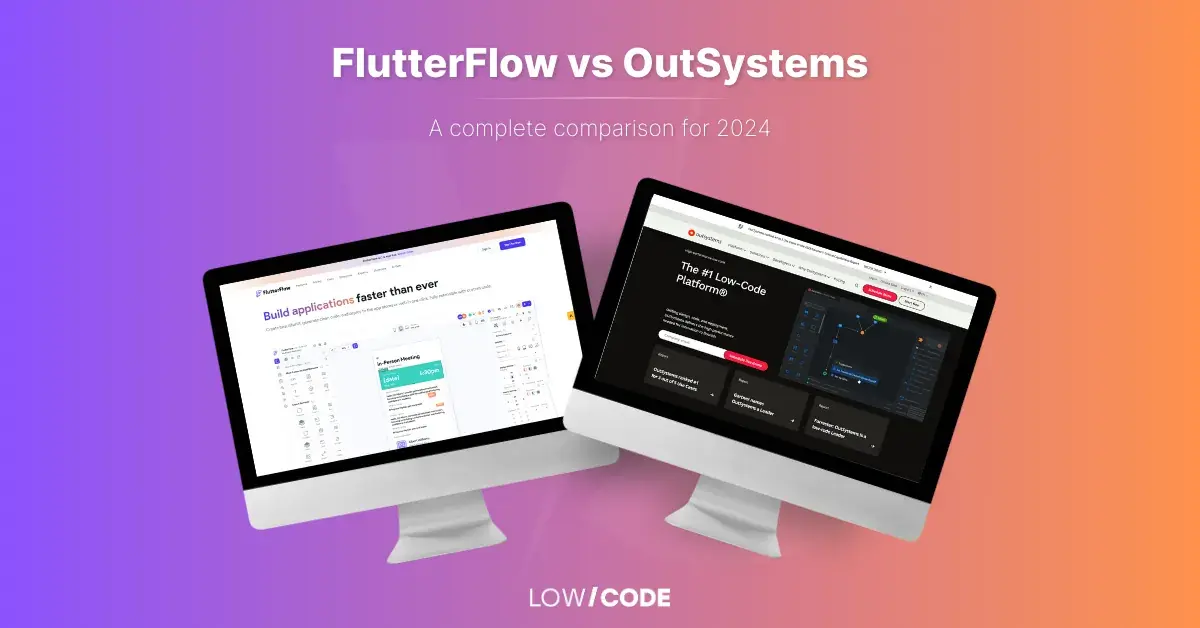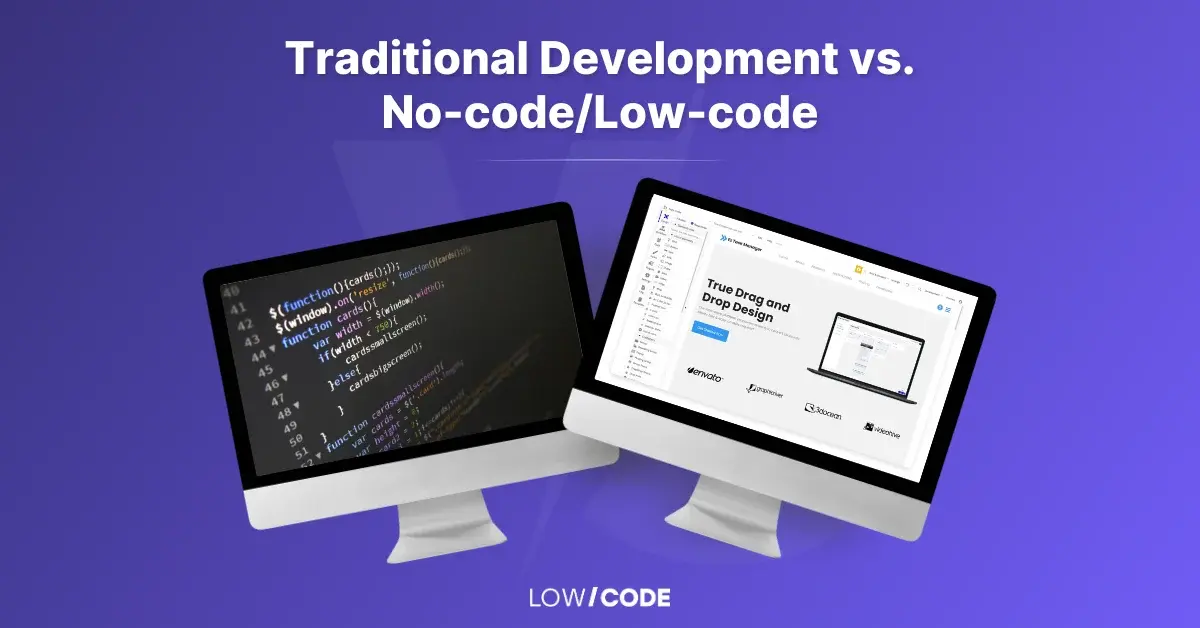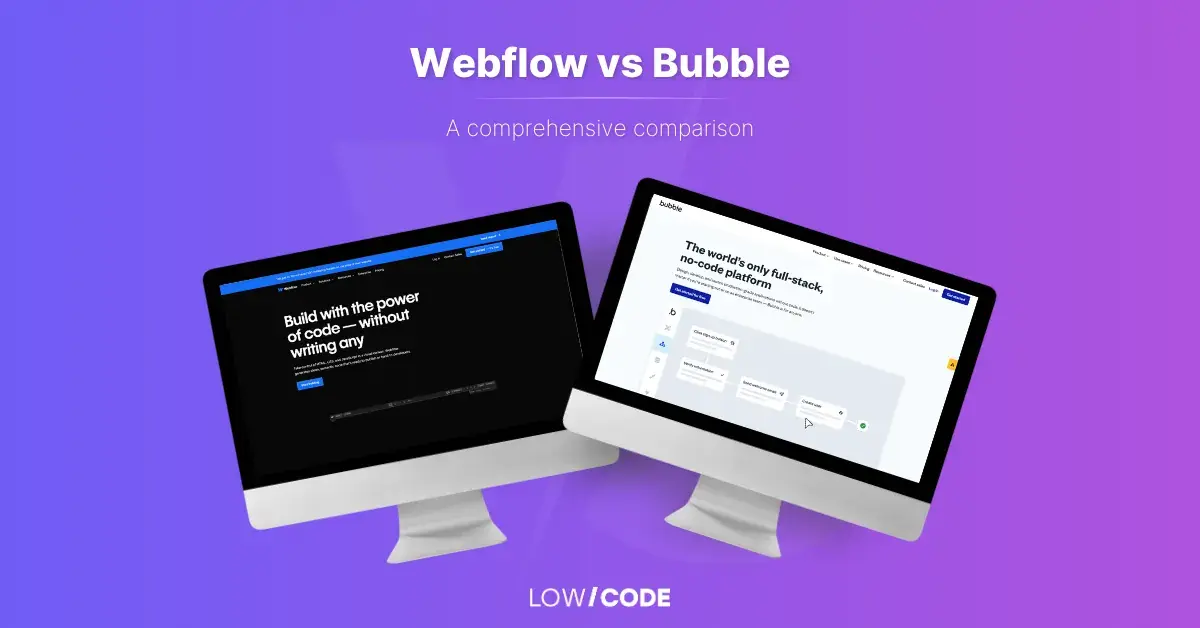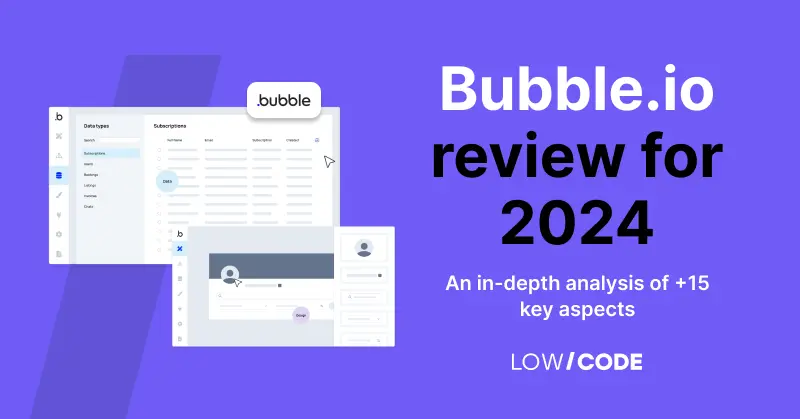.webp)
Can I build a mobile app with Bubble and how to do it?
Can you create a mobile app using Bubble? Bubble.io is a popular no-code platform for fast web app development. But here's the twist: Web apps (even responsive ones) and mobile apps are not quite the same. In this article, we'll explore how to adapt your Bubble creation for mobile devices. We'll discuss the steps to make your Bubble app mobile-friendly, look at mobile wrapper options, and highlight potential challenges. By the end, you'll have a clear picture of what Bubble can do for you and if it's the right choice for your project.
TL;DR
Bubble offers mobile app possibilities through adaptation as a native app or Progressive Web App (PWA). Mobile wrappers play a crucial role in this process. To begin, optimize your Bubble app for mobile use using responsive editing and a customized mobile experience. Then, choose between wrapping your app as a native one or opting for the user-friendly PWA route. Each approach has its unique benefits and limitations, so consider your project's specific needs carefully.
Can you build a mobile app with Bubble
Let's begin by establishing that Bubble primarily focuses on web applications. Web apps rely on web browsers to function, and browsers are the ones that actually handle tasks like displaying content (HTML/CSS), loading resources, updating the interface when needed, and running scripts (such as JavaScript).
To answer the question, "Can you build a mobile app with Bubble?"—yes, you can indeed create mobile applications with Bubble, but it's essential to understand the distinctions among responsive web apps, native mobile apps, and progressive web apps (PWAs).
Responsive web apps
Responsive web apps are designed to adapt seamlessly to various screen sizes and orientations. They provide users with a consistent experience across devices, including mobile phones, tablets, and desktop computers. These apps are accessed through web browsers on mobile devices, such as Chrome or Safari, without the need for installation from an app store.
While responsive web apps offer convenience in terms of accessibility and cross-device compatibility, they may lack certain native mobile app features. For instance, they often do not have the capability for offline access or push notifications. Nevertheless, responsive design principles ensure that users can navigate and interact with the app comfortably on smaller screens, making them a cost-effective solution for reaching a wide audience.
Native mobile apps
Native mobile apps are tailored to specific mobile platforms, such as iOS (Apple) or Android (Google) and are developed using platform-specific programming languages and frameworks like Swift or Java. One of the key advantages of native apps is their superior performance. They can harness the full potential of a device's hardware and APIs, resulting in smoother and faster user experiences.
Native mobile apps are distributed through official app stores, such as the Apple App Store and Google Play Store. This distribution model ensures security, and trustworthiness, and provides a centralized platform for app discovery, installation, and updates. Additionally, native apps have access to a wide array of device features, including GPS, camera, sensors, and offline functionality, allowing them to offer a rich and versatile user experience.
Progressive web apps (PWAs)
Progressive web apps (PWAs) combine the best of both web and native mobile app worlds. They are essentially web applications but offer a user experience similar to native mobile apps. PWAs can be installed on users' devices, creating an icon on the home screen for easy access, much like traditional apps from app stores.
What sets PWAs apart is their ability to provide advanced features commonly associated with native mobile apps. This includes offline functionality, push notifications, and responsive design. PWAs bridge the gap between web and native apps, allowing businesses to reach a broader audience while still delivering a compelling and app-like user experience. They are particularly appealing to organizations looking to expand their mobile presence without the development overhead of separate native apps.
Overview:
- Responsive web apps
- Adapt to different screen sizes and orientations.
- Accessed through web browsers on mobile devices.
- Offer a user experience optimized for mobile but lacks native mobile features.
- Native mobile apps
- Specifically designed for iOS or Android platforms.
- Provide superior performance, access to device features, and a seamless user experience.
- Available for download and installation from app stores.
- Progressive web apps (PWAs)
- Combine the best of web and native mobile apps.
- It can be installed on users' devices like traditional apps.
- It offers offline capabilities, push notifications, and responsive design.
Bubble primarily focuses on web app development, and while it can be used to create mobile-friendly apps, they are essentially web apps optimized for mobile browsers. For full-fledged mobile apps with a presence in app stores, additional development or integration with mobile wrappers may be necessary. We’ll talk more about this in the next sections.
Learn more: Building a Web App with Bubble: Everything You Need to Know
Why build a native Bubble mobile app
Building a native Bubble mobile app, as opposed to relying solely on a web app, can offer several advantages.
- Optimization: Native mobile apps are optimized for the specific operating system (iOS or Android), resulting in faster loading times and smoother user experiences. You’d find this level of optimization challenging to achieve with web apps.
- Access to hardware features: Native apps have direct access to a device's hardware and features, such as GPS, camera, push notifications, or sensors, therefore, you can develop more feature-rich and interactive applications.
- Presence in app stores: Publishing a native app on app stores like the Apple App Store and Google Play Store provides exposure to a vast and diverse user base. It enhances discoverability and trust, as users often prefer downloading apps from official app stores.
- Monetization: Native apps offer various monetization options, such as in-app purchases, subscriptions, and advertising. It depends on the kind of app you’re going to develop but in some cases, this revenue stream can be more effective and lucrative compared to web-based advertising models.
- Offline access: Some industries, like travel or remote work tools, demand offline functionality. Mobile apps can provide users with uninterrupted access to critical information, even in areas with poor or no internet connectivity.
Testimonial - From a dev point of view
How well would you say bubble works for mobile apps?
I think that Bubble is great for building mobile apps unless you are creating something really complex. For example, we are currently reviewing an app built on Bubble that has a lot of features. It allows users to create calendar events, process payments, and share these events, it also integrates with Google Maps. However, if your project requires more advanced and complex features, you might need to consider other development approaches. But I'd say this holds true not just for Bubble but for other no-code platforms too.
How to build a Bubble mobile app

Native app or PWA?
Technically speaking, you can't build a standalone mobile app with Bubble. Instead, we're here to guide you on adapting your Bubble app for mobile usage and getting it as close as possible to being a native mobile app experience. You have two main options: wrapping it as a native app or making it a Progressive Web App (PWA).
You might be wondering about the contradiction since we mentioned you can't build a native app with Bubble. Here's the explanation: A mobile wrapper is like a full-screen browser, but it's customized to run only specific web addresses (URLs), hiding the usual browser elements like the URL bar and menus. With a mobile wrapper, you can package your Bubble app as a standalone application that users can download from app stores. They get the convenience of accessing your app as if it were a native app, even though, in reality, they're essentially downloading a browser tuned to your app's URL.
It's important to clarify that this method doesn't create a true native Bubble.io iOS or APK app. Instead, it's a clever hybrid solution, combining web-based development with app store distribution.
On the other hand, we have PWAs. As we previously mentioned, they offer a native app-like experience without the need for users to download software from an app store.
While it's possible to build a PWA from scratch, it can be complex and isn't recommended, especially if you don’t have a lot of experience in JavaScript. Fortunately, there are also third-party wrappers available to simplify the process.
First step: Make your bubble app mobile-friendly
Before diving into app wrapping, let’s start with some tips for optimizing the mobile experience of your Bubble app. You can use the following features:
- Responsive editor: Utilize the responsive editor to adjust how your app's content appears on devices of various sizes.
- "This Page is a Native App" checkbox: Enable this option to receive tips on adapting your app for app store submission. You can also designate a native app name.
- Mobile version: Select a specific page to display on mobile devices, tailored to their design needs.
- iOS appearance: Customize your Bubble app's appearance on iOS devices, ensuring it looks great on iPhones and iPads.
- Hide elements & animations: Enhance the user experience by hiding elements and employing smooth animations.
- Ionic elements: Consider integrating Ionic elements designed for mobile devices into your app.
Second step: Use a mobile wrapper
Now is the time to use a mobile wrapper service that aligns with your specific requirements and budget (don't worry; we have a list of recommended mobile wrappers prepared for you in the next section).
Once you've identified the mobile wrapper service that suits your needs, proceed to sign up for the service or make the necessary purchase, depending on the pricing model they offer. Typically, these services offer straightforward registration processes, and you may be required to provide basic account information.
Your next steps are:
- Customize the mobile features you want to include in your app, such as push notifications, biometric authentication, QR/barcode scanning, and more, depending on the wrapper's capabilities.
- Many mobile wrapper services provide a preview option. Use this to test your app's functionality and appearance on mobile devices before finalizing.
- Once you're satisfied with the settings and preview, proceed to generate or wrap your app. The mobile wrapper will give you the steps you need to follow and then package your Bubble app to work as a native app or PWA, depending on your choice.
- If you're creating a native app, you may need to follow additional steps to submit your app to app stores. The mobile wrapper service might provide guidance on this process.
Wrappers for native apps:
BDK
- BDK specializes in wrapping Bubble apps and offers native features integration via a Bubble plugin.
- Its features include push notifications, biometrics, QR/barcode scanning, GPS, custom splash screens, and more.
- Pricing starts at $349 for both iOS and Android, with plugins available at $16 or $4/month.
Nativator.io
- Nativator.io can wrap a variety of apps into native iOS and Android apps.
- Its features include white-labeled splash screens, camera/file upload, geolocation, push notifications, and more.
- Prices range from $59 to $9.99/month, depending on platform compatibility.
GoNative
- GoNative transforms Bubble apps into native apps, ensuring acceptance in app stores.
- Its features include native UI, native plugins, and professional services.
- Pricing begins at a one-time fee of $790 for both iOS and Android.
Wrapper for PWAS
Progressier
- Progressier converts Bubble apps into Progressive Web Apps (PWAs).
- Its features include installation statistics, API, push notifications, and iOS compatibility.
- The pricing is based on the number of apps, starting at $15/month for the first app.
Limitations of building a mobile app with Bubble.io
Dependency on server connection
Bubble apps rely entirely on server connections to run and render pages. Unlike native apps, which allow offline access and sync data when connected, Bubble apps cannot even display pages without an active server connection.
Rendering and responsiveness
Bubble's reliance on the server and JavaScript for visual changes can result in slightly less smooth rendering and responsiveness compared to native apps. While these differences are subtle, they may affect the app's overall user experience.
Long-term scalability
As your Bubble app grows and attracts more users, scalability becomes a significant concern, particularly if you have a mobile-heavy audience. You might encounter challenges related to performance, real-time data management, and ensuring a seamless user experience. In this case, you may need to explore the development of a native app.
Limitations of PWAs
Progressive Web Apps (PWAs), while OS-agnostic, face varying levels of acceptance by operating systems. Google's Android app store relatively supports PWAs, but Apple restricts PWAs from accessing native features and only permits native apps on the Apple app store.
Native app development challenges
Native app development is a longer process, involving app store screening and adherence to specific operating systems (iOS or Android). Building for both iOS and Android requires creating two separate native apps. Native apps must be installed on users' devices, unlike web-based apps that can be quickly accessed online.
Do you have a project in mind? Connect with us now for expert guidance and a personalized quote based on your specific requirements. Book a free discovery call today with our Bubble.io agency!





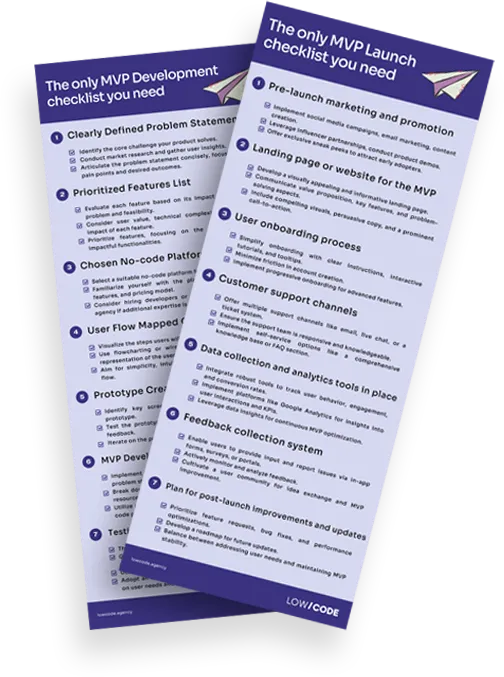
%20(Custom).webp)



